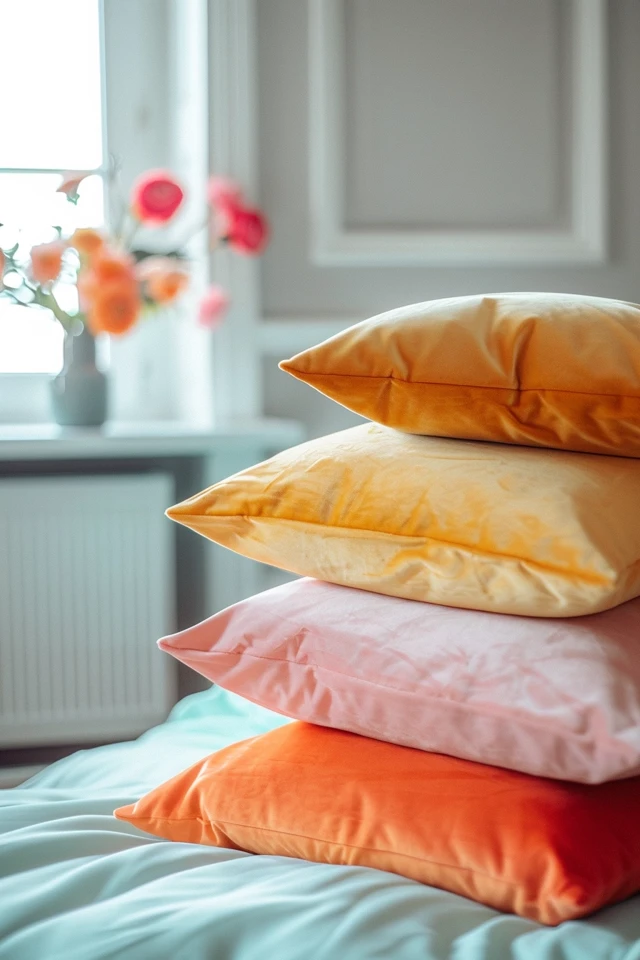Hi there! I’m here to share some pillow cleaning tips and practices to help you maintain good sleep hygiene. We all love a cozy pillow, but neglecting pillow care can lead to stains and odors that affect our sleep health. So, let’s dive into the world of pillow stain removal and keeping your pillows clean!
When it comes to pillow cleaning, it’s essential to understand that different types of pillows require different methods. Cotton, feather, down, and fiber pillows can typically be washed in a machine. On the other hand, foam pillows need to be cleaned by hand to prevent damage. Taking care of your pillows not only removes dirt and allergens but also helps them last longer, ensuring a fresh and clean sleep environment.
Key Takeaways:
- Regular pillow washing, 2 to 4 times a year, is essential for maintaining good sleep hygiene.
- Different types of pillows require different cleaning methods: machine washing for cotton, feather, down, and fiber pillows, and hand cleaning for foam pillows.
- In addition to washing, daily care for pillows includes airing them outside, spot-cleaning stains, and using protective covers.
- Pillow care routine helps remove stains, odors, and allergens, resulting in a clean and fresh sleeping environment.
- By following these pillow cleaning tips, you can extend the lifespan of your pillows and enjoy healthier sleep.

How often should you wash your pillows?
When it comes to pillow cleaning, it’s important to establish a regular washing routine. I recommend washing your pillows 2 to 4 times a year. Why? Well, think about it – your head and face come into direct contact with your pillow every single night. Over time, pillows accumulate sweat, dirt, dead skin cells, and even allergens. By washing your pillows regularly, you can remove these contaminants and ensure a clean and fresh sleeping environment.
It’s worth mentioning that pillows with noticeable stains or unpleasant odors should be replaced instead of washed. Sometimes, no matter how hard you try, certain stains or smells may become permanent. But for general cleaning and maintenance, a regular washing schedule is highly recommended.
By washing your pillows according to this recommended frequency, you can keep them in good condition, extend their lifespan, and enjoy a healthier sleep environment free from allergens and accumulated grime.
Remember, a clean pillow is not only more hygienic but also contributes to a more comfortable and restful sleep experience.
The benefits of regular pillow washing
- Removes sweat, dirt, dead skin cells, and allergens
- Prolongs the lifespan of your pillows
- Maintains a clean and fresh sleeping environment
- Reduces the risk of allergies and skin irritations
Now that you know how often to wash your pillows, let’s move on to the next section where I’ll explain the different methods for washing pillows based on their material.

How to wash your pillows
When it comes to washing pillows, the method you use will depend on the type of pillow you have. Here are some common pillow washing methods to help you keep your pillows clean and fresh:
Machine washing cotton, feather, down, and fiber pillows:
If you have cotton, feather, down, or fiber pillows, you can wash them in a washing machine. Start by pre-treating any tough stains with a bleach solution. Then, place two pillows in the machine to balance the load. Use warm water and a mild detergent to ensure gentle yet effective cleaning. Make sure to select a delicate or gentle cycle to avoid damaging the pillows. After the wash cycle is complete, it’s best to air dry the pillows or use the dryer with low heat. This will help maintain the integrity of the pillows and prevent them from losing their shape. Remember to read the care instructions on the pillow label for specific guidelines.
Hand washing foam pillows:
Foam pillows require a different cleaning approach. They should be cleaned by hand to prevent damage. Begin by filling a bathtub with warm water and adding a mild detergent. Submerge the foam pillow in the soapy water and gently agitate it to allow the detergent to penetrate the material. Afterward, thoroughly rinse the pillow with clean water to remove any soap residue. It’s crucial to ensure that the foam pillow is completely dry before using it again to prevent the growth of mold or mildew. Allow it to air dry naturally or use a fan to speed up the drying process.
Remember to always follow the care instructions provided by the pillow manufacturer to ensure the best cleaning results. By properly washing your pillows, you’ll maintain their cleanliness and keep them in optimal condition for a comfortable night’s sleep.

Conclusion
Taking care of your pillows is crucial for maintaining good sleep hygiene. Regular pillow washing can remove stains, odors, and allergens, ensuring a clean and fresh sleeping environment.
Different types of pillows require different cleaning methods, so it is important to read the care instructions. Cotton, feather, down, and fiber pillows can be washed in a machine, while foam pillows need to be cleaned by hand.
In addition to washing, daily care for your pillows includes airing them outside and using protective covers. These simple sleep hygiene tips can help extend the lifespan of your pillows and create a healthier sleep environment for you and your family.
By following proper pillow care routines and maintaining a clean sleeping environment, you can enjoy restful nights of sleep and wake up feeling refreshed and energized.

